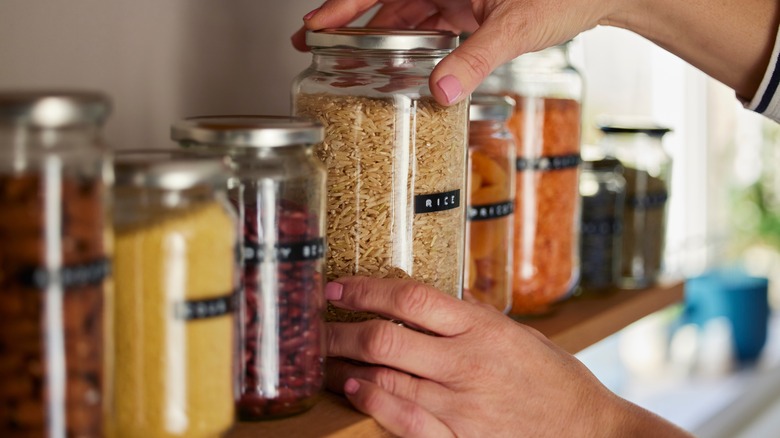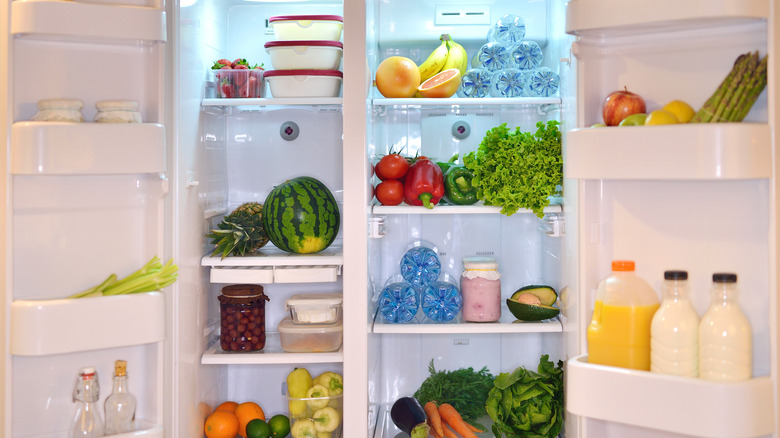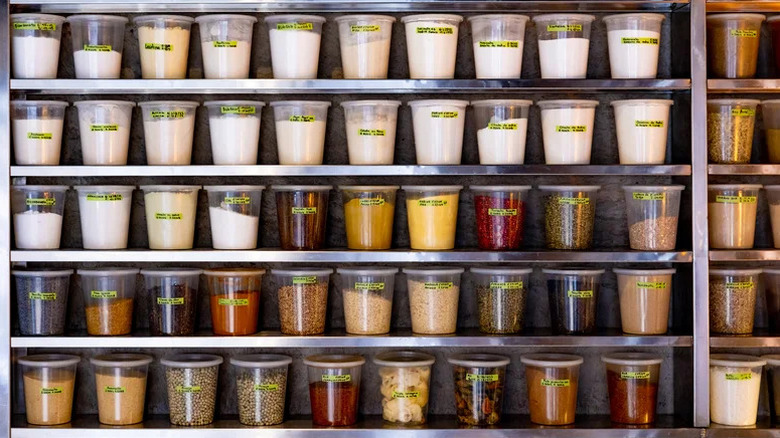FIFO: The Rule You Need To Store Food Like A Chef
"FIFO" might sound like the name of a sports organization or TV channel, but it's actually a mantra followed by professional chefs. The acronym stands for "first in, first out," meaning that the oldest food in the fridge or pantry gets eaten first, and these older foods are stored at the front of a storage space for easy access. It's a simple concept, but can have a huge impact on the organization of your kitchen, and helps you waste less money and food.
FIFO sounds simple enough, but it's surprisingly easy to stray away. Say you just brought home a container of bright red strawberries that you want to snack on, but you have a languishing carton of blueberries in the fridge, which you ignore, in the moment. You might also overlook a half-used carton of milk when it's been pushed to the back of the fridge. Or maybe you're making a big batch of cookies, and you grab a new bag of flour because you know you'll need several cups, rather than reaching for the dregs of the last package. Before you know it, you've got fuzzy blueberries, spoiled milk, and stale-tasting flour.
Luckily, enforcing FIFO is as simple as storing groceries wisely when you bring them home, and re-arranging your kitchen every so often to make sure old food is at the front and newer items are at the back. A few more food storage tips can help you get the most out of this system.
How to organize your food the FIFO way
When you get home from the grocery store, it's tempting to shove products in your fridge or cabinet and be done with it, but taking a few extra minutes to rearrange things will make FIFO easy to follow. Older produce, dairy, meats, and even shelf-stable products should be moved to the front of the line, and you should stick any new purchases behind them. It's especially important to prioritize items that are already opened, such as a carton of milk or container of soup. This system helps you avoid ending up with spoiled food; keeps you aware of what you have on hand, so you don't buy items unnecessarily; and helps you achieve a cleaner refrigerator.
Additionally, don't forget the freezer! Half-empty bags of frozen fruits and vegetables can easily get left behind if you don't use the FIFO technique, as well as cartons of ice cream or frozen leftovers. There's nothing worse than freezer-burnt food, so FIFIO-fy your freezer, too. To further help with organization, consider learning when to decant pantry staples versus when to leave them in the package. Decanting not only keeps foods fresher, but the containers and jars you have on hand might be easier to stack and arrange, compared to flimsy bags of spices, sugar, and flour.
The tools you need to FIFO like a pro
Fancy label-making machines and pretty glass mason jars can certainly help you keep your whole kitchen organized. However, professional chefs tend to opt for a more analog solution: a roll of masking tape and a permanent marker. Just write the date you opened, cooked, or stashed a food item on a piece of masking tape, and stick it on the storage container. Even if the contents of the container seem obvious, go ahead and write down the name of the item, as well. That way, everyone in your household is on the same page about what needs to be eaten and how quickly. Also, if you end up freezing the food, you won't have to wonder, "Is that gravy or caramel sauce?"
The containers you choose for leftovers should be made out of a clear material, and should be completely airtight. Restaurant chefs favor plastic deli containers, which are durable, very affordable, and easy to stack, making them perfect for both leftovers and decanting ingredients. With these tips, you'll be FIFO-ing like you're a star on "The Bear" in no time.



